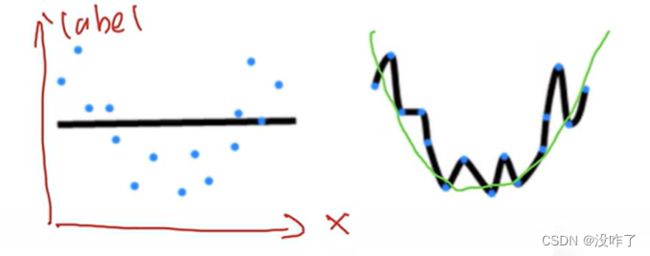模型选择 + 过拟合和欠拟合(动手学深度学习v2)笔记
训练误差和泛化误差
- 训练误差(training error):模型在训练数据集上计算得到的误差
- 泛化误差(generalization error):模型应用在同样从原始样本的分布中抽取的无限多数据样本时,模型误差的期望
验证数据集和测试数据集
- 验证数据集:选择模型超参数,一个用来评估模型好坏的数据集
- 例如拿出50%的训练数据
- 不要跟训练数据混在一起(常犯错误)
- 测试数据集:只用一次的数据集。
- 训练数据集:训练模型参数
K折交叉验证
在没有足够多数据时使用(非大数据集上通常使用)(这是常态)
算法:
- 将训练数据分割成K块
- For i = 1,...,K
- 使用第i块作为验证数据集,其余的作为训练数据集
- 报告K个验证集误差的平均
常用:K=5 或 10
这里,原始训练数据被分成K个不重叠的子集。 然后执行K次模型训练和验证,每次在K−1个子集上进行训练,并在剩余的一个子集(在该轮中没有用于训练的子集)上进行验证。 最后,通过对K次实验的结果取平均来估计训练和验证误差。
过拟合和欠拟合
模型容量
- 拟合各种函数的能力
- 低容量的模型难以拟合训练数据
- 高容量的模型可以记住所有的训练数据
模型容量的影响
估计模型容量
-
难以在不同的种类算法之间比较
-
例如树模型和神经网络
-
-
给定一个模型种类,将有两个主要因素
-
参数的个数
-
参数值的选择范围
-
VC维
- 统计学习理论的一个核心思想
- 对于一个分类模型,VC等于一个最大的数据集的大小,不管如何给定标号,都存在一个模型来对它进行完美分类
线性分类器的VC维
- 2维输入的感知机,VC维=3
- 能够分类任何三个点,但不是4个(xor)
- 支持N维输入的感知机的VC维是N+1
- 一些多层感知机的VC维O(N logN)
VC 维的用处
- 提供为什么一个模型好的理论依据
- 它可以衡量训练误差和泛化误差之间的间隔
- 但深度学习中很少使用
- 衡量不是很准确
- 计算深度学习模型的VC维很困难
数据复杂度
- 多个重要因素
- 样本个数
- 每个样本的元素个数
- 时间、空间结构
- 多样性
总结
- 模型容量需要匹配数据复杂度,否则可能导致欠拟合和过拟合
- 统计机器学习提供数学工具来衡量模型复杂度
- 实际中一般靠观察训练误差和验证误差
代码实现:
使用以下三阶多项式来生成训练和测试数据的标签:
import math
import numpy as np
import torch
from torch import nn
from d2l import torch as d2l
max_degree = 20 # 多项式的最大阶数
n_train, n_test = 100, 100 # 训练和测试数据集大小
true_w = np.zeros(max_degree) # 分配大量的空间
true_w[0:4] = np.array([5, 1.2, -3.4, 5.6])
features = np.random.normal(size=(n_train + n_test, 1)) #numpy.random.normal(loc=0,scale=1e-2,size=shape) ,loc(float):正态分布的均值,scale(float):正态分布的标准差,参数size(int 或者整数元组):输出的值赋在shape里,默认为None。
np.random.shuffle(features) # 对数组进行重新排列
poly_features = np.power(features, np.arange(max_degree).reshape(1, -1)) # power(x, y) 函数,计算x的y次方
for i in range(max_degree):
poly_features[:, i] /= math.gamma(i + 1) # gamma(n)=(n-1)!
# labels的维度:(n_train+n_test,)
labels = np.dot(poly_features, true_w)
labels += np.random.normal(scale=0.1, size=labels.shape)
#从生成的数据集中查看一下前2个样本, 第一个值是与偏置相对应的常量特征
# NumPy ndarray转换为tensor
true_w, features, poly_features, labels = [torch.tensor(x, dtype=torch.float32) for x in [true_w, features, poly_features, labels]]
features[:2], poly_features[:2, :], labels[:2]# 实现一个函数评估给定数据集上的损失
def evaluate_loss(net, data_iter, loss):
metric = d2l.Accumulator(2) # 损失的总和,样本数量
for X, y in data_iter:
out = net(X)
y = y.reshape(out.shape)
l = loss(out, y)
metric.add(l.sum(), l.numel())
return metric[0] / metric[1]
# 定义训练函数
def train(train_features, test_features, train_labels, test_labels, num_epochs=400):
loss = nn.MSELoss(reduction='none')
input_shape = train_features.shape[-1]
# 不设置偏置,因为我们已经在多项式中实现了它
net = nn.Sequential(nn.Linear(input_shape, 1, bias=False))
batch_size = min(10, train_labels.shape[0])
train_iter = d2l.load_array((train_features, train_labels.reshape(-1,1)), batch_size)
test_iter = d2l.load_array((test_features, test_labels.reshape(-1,1)), batch_size, is_train=False)
trainer = torch.optim.SGD(net.parameters(), lr=0.01)
animator = d2l.Animator(xlabel='epoch', ylabel='loss', yscale='log',
xlim=[1, num_epochs], ylim=[1e-3, 1e2],
legend=['train', 'test'])
for epoch in range(num_epochs):
d2l.train_epoch_ch3(net, train_iter, loss, trainer)
if epoch == 0 or (epoch + 1) % 20 == 0:
animator.add(epoch + 1, (evaluate_loss(net, train_iter, loss),
evaluate_loss(net, test_iter, loss)))
print('weight:', net[0].weight.data.numpy())# 三阶多项式函数拟合(正常)
# 从多项式特征中选择前4个维度,即1,x,x^2/2!,x^3/3!
train(poly_features[:n_train, :4], poly_features[n_train:, :4], labels[:n_train], labels[n_train:])
# 结果表明,该模型能有效降低训练损失和测试损失。 学习到的模型参数也接近真实值。# 线性函数拟合(欠拟合)
# 从多项式特征中选择前2个维度,即1和x
train(poly_features[:n_train, :2], poly_features[n_train:, :2], labels[:n_train], labels[n_train:])
# 线性函数拟合,减少该模型的训练损失相对困难。 在最后一个迭代周期完成后,训练损失仍然很高。# 高阶多项式函数拟合(过拟合)
# 从多项式特征中选取所有维度
train(poly_features[:n_train, :], poly_features[n_train:, :], labels[:n_train], labels[n_train:], num_epochs=2000)
# 没有足够的数据用于学到高阶系数应该具有接近于零的值。 因此,这个过于复杂的模型会轻易受到训练数据中噪声的影响。 虽然训练损失可以有效地降低,但测试损失仍然很高。 结果表明,复杂模型对数据造成了过拟合。







